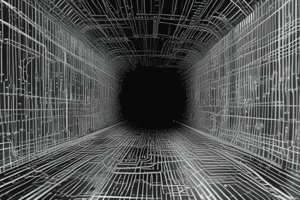Podcast
Questions and Answers
What is the result of subtracting a fixed positive quantity from the time variable in a signal?
What is the result of subtracting a fixed positive quantity from the time variable in a signal?
- The signal is shifted to the left.
- The signal is shifted to the right. (correct)
- The signal is dilated.
- The signal is compressed.
What is the result of multiplying the time variable by a quantity greater than one in a signal?
What is the result of multiplying the time variable by a quantity greater than one in a signal?
- The signal becomes wider.
- The signal remains unchanged.
- The signal is reversed.
- The signal becomes narrower. (correct)
What is the effect of adding a fixed positive amount to the time variable in a signal?
What is the effect of adding a fixed positive amount to the time variable in a signal?
- The signal is reversed.
- The signal is compressed.
- The signal is shifted to the left. (correct)
- The signal is shifted to the right.
What is the term for rotating a continuous time signal by 180° about the vertical axis?
What is the term for rotating a continuous time signal by 180° about the vertical axis?
What type of signal is x[n] an example of?
What type of signal is x[n] an example of?
What is the effect of multiplying the time variable by a quantity less than one in a signal?
What is the effect of multiplying the time variable by a quantity less than one in a signal?
What is the result of multiplying the time variable by a quantity in a signal?
What is the result of multiplying the time variable by a quantity in a signal?
What is the term for the operation of shifting a signal in time by adding or subtracting a quantity from the time variable?
What is the term for the operation of shifting a signal in time by adding or subtracting a quantity from the time variable?
What is the mathematical representation of time reversal for a continuous time signal x(t)?
What is the mathematical representation of time reversal for a continuous time signal x(t)?
What is the amplitude shifting operation on a continuous time signal x(t)?
What is the amplitude shifting operation on a continuous time signal x(t)?
What is the amplitude scaling operation on a discrete time sequence x(n)?
What is the amplitude scaling operation on a discrete time sequence x(n)?
What is the effect of amplitude scaling on a signal?
What is the effect of amplitude scaling on a signal?
What is the time reversal operation on a discrete time sequence x(n)?
What is the time reversal operation on a discrete time sequence x(n)?
What is a system in signal processing?
What is a system in signal processing?
What is the amplitude shifting operation on a discrete time sequence x(n)?
What is the amplitude shifting operation on a discrete time sequence x(n)?
What is the digital filter in digital domain?
What is the digital filter in digital domain?
Flashcards are hidden until you start studying
Study Notes
Introduction to Signals and Systems
- Signals are classified into continuous and discrete time signals.
- Continuous time signals are represented by x(t) and discrete time signals are represented by x[n].
Signal Operations
- Time shifting is the shifting of a signal in time by adding or subtracting a quantity to the time parameter.
- Subtracting a fixed positive quantity from the time variable will shift the signal to the right (delay) by the subtracted quantity.
- Adding a fixed positive amount to the time variable will shift the signal to the left (advance) by the added quantity.
- Time scaling compresses or dilates a signal by multiplying the time variable by some quantity.
- If the quantity is greater than one, the signal becomes narrower and the operation is called compression.
- If the quantity is less than one, the signal becomes wider and is called dilation.
- Time reversal of a continuous-time signal x(t) is given by y(t) = x(-t).
- Time reversal of a discrete-time sequence x(n) is given by y(n) = x(-n).
- Amplitude shifting means shifting of signal in the amplitude domain around the X-axis.
- When K is greater than zero, the shifting of signal takes place towards up in the X-axis (upward shifting).
- When K is less than zero, the shifting of signal takes place towards down in the X-axis (downward shifting).
- Amplitude scaling of a signal rescales the amplitude of the signal, either amplifying or attenuating it.
- The shape of the resulting signal remains the same as that of the original signal, but the amplitude is altered.
Systems
- A system is a mathematical model that represents the transformation of some input signal x(t) into an output signal y(t).
- In the digital domain, a system may be a digital filter.
- Digital filters use a digital processor to perform numerical calculations on sampled values of the signal.
Studying That Suits You
Use AI to generate personalized quizzes and flashcards to suit your learning preferences.




